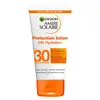What's inside
What's inside
 Key Ingredients
Key Ingredients

 Benefits
Benefits

 Concerns
Concerns

 Ingredients Side-by-side
Ingredients Side-by-side

Water
Skin ConditioningDiethylamino Hydroxybenzoyl Hexyl Benzoate
UV FilterHomosalate
Skin ConditioningDiisopropyl Sebacate
EmollientBis-Ethylhexyloxyphenol Methoxyphenyl Triazine
Skin ConditioningDibutyl Adipate
EmollientGlycerin
HumectantEthylhexyl Salicylate
UV AbsorberEthylhexyl Triazone
UV AbsorberButylene Glycol
HumectantLauroyl Lysine
Skin ConditioningPropanediol
SolventSilica
AbrasiveSodium Citrate
BufferingHydroxyethyl Acrylate/Sodium Acryloyldimethyl Taurate Copolymer
Emulsion StabilisingPolyacrylate Crosspolymer-6
Emulsion StabilisingPentylene Glycol
Skin ConditioningCopper Sulfate
Skin Conditioning1,2-Hexanediol
Skin ConditioningCaprylyl Glycol
EmollientCitric Acid
BufferingEctoin
Skin ConditioningMannitol
HumectantSodium Hyaluronate
HumectantXylitol
HumectantZinc Sulfate
AntimicrobialVitis Vinifera Vine Extract
Skin ConditioningRhamnose
HumectantPolysorbate 60
EmulsifyingSorbitan Isostearate
EmulsifyingAsiaticoside
AntioxidantMadecassic Acid
Skin ConditioningAsiatic Acid
Skin ConditioningAcetyl Dipeptide-1 Cetyl Ester
Skin ConditioningFructooligosaccharides
HumectantCaprylic/Capric Triglyceride
MaskingLaminaria Ochroleuca Extract
Skin ConditioningWater, Diethylamino Hydroxybenzoyl Hexyl Benzoate, Homosalate, Diisopropyl Sebacate, Bis-Ethylhexyloxyphenol Methoxyphenyl Triazine, Dibutyl Adipate, Glycerin, Ethylhexyl Salicylate, Ethylhexyl Triazone, Butylene Glycol, Lauroyl Lysine, Propanediol, Silica, Sodium Citrate, Hydroxyethyl Acrylate/Sodium Acryloyldimethyl Taurate Copolymer, Polyacrylate Crosspolymer-6, Pentylene Glycol, Copper Sulfate, 1,2-Hexanediol, Caprylyl Glycol, Citric Acid, Ectoin, Mannitol, Sodium Hyaluronate, Xylitol, Zinc Sulfate, Vitis Vinifera Vine Extract, Rhamnose, Polysorbate 60, Sorbitan Isostearate, Asiaticoside, Madecassic Acid, Asiatic Acid, Acetyl Dipeptide-1 Cetyl Ester, Fructooligosaccharides, Caprylic/Capric Triglyceride, Laminaria Ochroleuca Extract
Water
Skin ConditioningGlycerin
HumectantOctocrylene
UV AbsorberPropylene Glycol
HumectantDiisopropyl Sebacate
EmollientEthylhexyl Salicylate
UV AbsorberAlcohol Denat.
AntimicrobialButyl Methoxydibenzoylmethane
UV AbsorberTitanium Dioxide
Cosmetic ColorantIsohexadecane
EmollientEthylhexyl Triazone
UV AbsorberAluminum Starch Octenylsuccinate
AbsorbentStearic Acid
CleansingTriethanolamine
BufferingPotassium Cetyl Phosphate
EmulsifyingTalc
AbrasiveSynthetic Wax
AbrasiveAscorbyl Glucoside
AntioxidantTocopherol
AntioxidantPhenoxyethanol
PreservativePEG-100 Stearate
Palmitic Acid
EmollientDimethicone
EmollientLimonene
PerfumingXanthan Gum
EmulsifyingBenzyl Salicylate
PerfumingBenzyl Alcohol
PerfumingLinalool
PerfumingCaprylyl Glycol
EmollientTerephthalylidene Dicamphor Sulfonic Acid
UV AbsorberAcrylates/C10-30 Alkyl Acrylate Crosspolymer
Emulsion StabilisingGeraniol
PerfumingDisodium EDTA
Citral
PerfumingCitronellol
PerfumingAluminum Hydroxide
EmollientCoumarin
PerfumingGlyceryl Stearate
EmollientParfum
MaskingWater, Glycerin, Octocrylene, Propylene Glycol, Diisopropyl Sebacate, Ethylhexyl Salicylate, Alcohol Denat., Butyl Methoxydibenzoylmethane, Titanium Dioxide, Isohexadecane, Ethylhexyl Triazone, Aluminum Starch Octenylsuccinate, Stearic Acid, Triethanolamine, Potassium Cetyl Phosphate, Talc, Synthetic Wax, Ascorbyl Glucoside, Tocopherol, Phenoxyethanol, PEG-100 Stearate, Palmitic Acid, Dimethicone, Limonene, Xanthan Gum, Benzyl Salicylate, Benzyl Alcohol, Linalool, Caprylyl Glycol, Terephthalylidene Dicamphor Sulfonic Acid, Acrylates/C10-30 Alkyl Acrylate Crosspolymer, Geraniol, Disodium EDTA, Citral, Citronellol, Aluminum Hydroxide, Coumarin, Glyceryl Stearate, Parfum
 Reviews
Reviews

Ingredients Explained
These ingredients are found in both products.
Ingredients higher up in an ingredient list are typically present in a larger amount.
Caprylyl Glycol is a humectant and emollient, meaning it attracts and preserves moisture.
It is a common ingredient in many products, especially those designed to hydrate skin. The primary benefits are retaining moisture, skin softening, and promoting a healthy skin barrier.
Though Caprylyl Glycol is an alcohol derived from fatty acids, it is not the kind that can dry out skin.
This ingredient is also used as a preservative to extend the life of products. It has slight antimicrobial properties.
Learn more about Caprylyl GlycolWe don't have a description for Diisopropyl Sebacate yet.
Ethylhexyl Salicylate is an organic compound used to block UV rays. It primarily absorbs UVB rays but offers a small amount of UVA protection as well.
Commonly found in sunscreens, Ethylhexyl Salicylate is created from salicylic acid and 2-ethylhexanol. You might know salicylic acid as the effective acne fighter ingredient and BHA.
The ethylhexanol in this ingredient is a fatty alcohol and helps hydrate your skin, similar to oils. It is an emollient, which means it traps moisture into the skin.
According to manufacturers, Ethylhexyl Salicylate absorbs UV wavelength of 295-315 nm, with a peak absorption at 307-310 nm. UVA rays are linked to long term skin damage, such as hyperpigmentation. UVB rays emit more energy and are capable of damaging our DNA. UVB rays cause sunburn.
Learn more about Ethylhexyl SalicylateEthylhexyl Triazone is a modern chemical sunscreen that protects from UV-B radiation.
It is the most effective of existing UV-B filters, as it provides the highest level of photo-stable absorption. It protects from the entire UV-B range (280 to 320nm), with it's highest level of protection at 314nm.
Ethylhexyl Triazone is oil soluble, oderless and colorless, which mean it is able to be incorporated into a variety of different formulations.
It is not currently available within the United States due to slow changing FDA regulations. Outside of the US, it is used in formulations at concentrations up to 5%.
Learn more about Ethylhexyl TriazoneGlycerin is already naturally found in your skin. It helps moisturize and protect your skin.
A study from 2016 found glycerin to be more effective as a humectant than AHAs and hyaluronic acid.
As a humectant, it helps the skin stay hydrated by pulling moisture to your skin. The low molecular weight of glycerin allows it to pull moisture into the deeper layers of your skin.
Hydrated skin improves your skin barrier; Your skin barrier helps protect against irritants and bacteria.
Glycerin has also been found to have antimicrobial and antiviral properties. Due to these properties, glycerin is often used in wound and burn treatments.
In cosmetics, glycerin is usually derived from plants such as soybean or palm. However, it can also be sourced from animals, such as tallow or animal fat.
This ingredient is organic, colorless, odorless, and non-toxic.
Glycerin is the name for this ingredient in American English. British English uses Glycerol/Glycerine.
Learn more about GlycerinWater. It's the most common cosmetic ingredient of all. You'll usually see it at the top of ingredient lists, meaning that it makes up the largest part of the product.
So why is it so popular? Water most often acts as a solvent - this means that it helps dissolve other ingredients into the formulation.
You'll also recognize water as that liquid we all need to stay alive. If you see this, drink a glass of water. Stay hydrated!
Learn more about Water